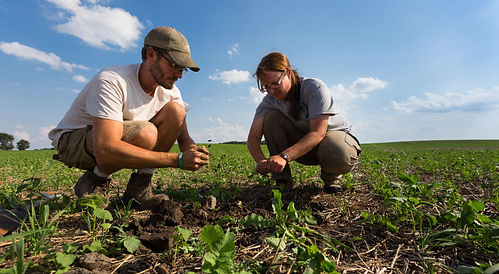My Molecular Health
The Why Behind 'Eat Fruit & Vegetables
Why agriculture?
It may seem a little odd to have information on farming, agriculture and gardening as part of a site about nutrition and health. But science is finding that food can be medicine and since the vast majority of our food comes via agriculture, the two fields are closely related. Advancements in one field may help advancements in the other.

Using an Ancient farming practice as climate change puts pressure on crops
Fred Yoder in Ohio plants rye and winter peas he never harvests. Larkin Martin in Alabama plants radishes she’ll never eat. A.G. Kawamura in California plants barley that rots in the fields.
Each is part of a small but growing movement to bring back an ancient agricultural practice called cover cropping that was once used to rejuvenate soil but now also likely comes with the added benefits of both mitigating climate change and protecting against its ravages.
It’s increasingly getting a push from Department of Agriculture programs and even companies that buy commodities. But mostly, farmers say it saves them money and protects their land.
“Our soils keep getting better and better. You take a shovel out and dig deep down and you see the earthworms and the absence of a hard pan. That soil is just mellow all the way through,” said Yoder, a fourth-generation family farmer in Plain City, Ohio.
For him, planting rye in his fields after he’s harvested his cash crops of corn and soybeans is no altruistic effort. It’s about economics and making his farm profitable.
“My biggest driver is trying to save money,” he said. “I’ve cut our fertilizer use by 20%, we’re skipping a herbicide application and my fields hold more water.”
Cover cropping is no panacea to the many struggles farmers face as they operate within the razor-thin margins of agriculture. It can be costly — as much as $35 an acre, takes several years to really make a difference, requires new timing and sometimes new equipment and can increase pest infestations.
But after a few years, fields planted in cover crops store thousands more gallons of water than bare fields during torrential rains, resist weeds' encroachment more, hold together better against erosion, survive droughts better and capture more carbon in their soils. Read More

Enhancement of phenolic and flavonoid compounds in cabbage
This research paper, Enhancement of phenolic and flavonoid compounds in cabbage (Brassica oleraceae) found that following the application of commercial seaweed extracts of the brown seaweed, (Ascophyllum nodosum) as a fertilizer increases the total Flavonoid and phenolic compounds in cabbage.
Cabbage, especially purple, is high on the list of foods containing good levels of nutrients.
A new agricultural revolution has started.
Congress must invest now to secure the future of U.S. food

Unless you’re in the industry, you might not know that agriculture is undergoing a quiet technological revolution. Drones, sensors, and satellite imaging systems help farms manage crops more effectively with more information and knowledge than ever before. Amid labor shortages, farmers are looking to robotics and automation to fill the gap. Artificial intelligence is now used to monitor soil, control pests, and improve overall yield. These and other advances are enabling the industry to rethink its most basic assumptions: how we grow, what we grow, and how we transport what we grow.
For example, recent breakthroughs in artificial intelligence, computer vision, and sensor and control systems have allowed our company, Bowery, to grow fresh, local, pesticide-free in large-scale, smart indoor environments with crops stacked from floor to ceiling. This approach, powered by renewable energy, uses significantly less land and water. It’s a sustainable model that works irrespective of changing climate conditions or severe weather events. Read the article